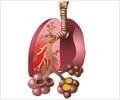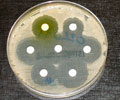A. baumannii can infect wounds and lead to especially persistent skin and soft tissue infections and eventually spread, causing difficult and sometimes impossible to treat systemic infections.

‘A. baumannii can infect wounds and lead to especially persistent skin and soft tissue infections and eventually spread, causing difficult and sometimes impossible to treat systemic infections such as pneumonia or urinary tract infections.’





Kumar Venkitanarayanan, Associate Dean for Research and Graduate Studies, and professor in the College of Agriculture, Health, and Natural Resources, and his team recently published research in the journal Wound Medicine detailing how they are working to change that. A. baumannii is included on the World Health Organization's ESKAPE list, a collection of bacteria that are becoming increasingly antibiotic-resistant. With resistance on the rise, research into alternative therapies is paramount, and in some cases returning to old therapies is proving effective.
Infections of A. baumannii are especially difficult to treat since the bacteria possess an arsenal of measures for acquiring antibiotic resistance, says Venkitanarayanan. The bacteria are also capable of forming biofilms that fortify the infection against antibiotics and affords them the increased chance of spreading, especially in hospital environments. "A. baumannii is primarily a nosocomial pathogen impacting those especially with compromised immune systems, the very young, the very old, burn victims, and is also reported in the wounds of combat soldiers," says Venkitanarayanan. "In the olden days, metals were used as antimicrobial treatments, so we decided to revisit those to see if they could be applied to modern-day treatments," says Venkitanarayanan.
Metals and metalloids have long been recognized for their disinfecting qualities, and as such have been used in food preservation, water disinfection, cleaning products, and for wound treatment. The researchers screened metals for their antimicrobial efficacy and found selenium, a metalloid, to be promising. In addition to potential antimicrobial uses, selenium also happens to be a micronutrient important in immune system functioning, nucleic acid synthesis, as well as other physiological processes.
The researchers first determined the minimum amount of selenium needed to inhibit the bacteria's virulence, or ability to cause disease. With this approach, Venkitanarayanan says the bacteria are still able to grow, but are not able to infect the host as effectively.
Advertisement
Next, the team simulated a wound by culturing cells and wound fluids in a model matrix. The wound matrix model was then inoculated with the bacteria, with or without the amount of selenium needed to inhibit A. baumannii virulence.
Advertisement
Bacteria can employ different strategies to colonize a host, from thick coatings to avoid desiccation or penetration from drugs, to means of attaching to and making their way into the host. It appears selenium has ways to dismantle multiple strategies in A. baumannii.
What the researchers found was that for the cultures exposed to selenium, the biofilm architecture of those cultures was significantly decreased, leaving the biofilm appearing diffuse and broken down. Correspondingly, the post-treatment genetic analysis revealed significant down-regulation of genes associated with biofilm production. Selenium also reduced the bacterial ability to adhere to and invade skin cells.
"There are no clear data for how selenium works. There appears to be toxicity against the outer membrane of the bacteria and it might also cause toxicity against the DNA, potentially in genes that are involved in biofilm creation," says Venkitanarayanan.
Studying these exact mechanisms are the next steps the researchers will be taking, thus getting one step closer to clinical applications.
Even though the exact mechanisms of action for selenium are not known at this time, Venkitanarayanan says it is important to explore these types of options. His group has explored selenium's efficacy for treating other infections such as enterohemorrhagic Escherichia coli (EHEC) and Clostridium difficile (C. diff). As more antibiotic resistance is encountered in treating various bacterial infections, Venkitanarayanan says that looking back to treatments that worked once upon a time is important.
"Even if we make use of the old methods in concert with modern antibiotics, it is better than not being able to use anything at all."
Source-Eurekalert















